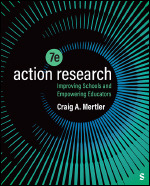Action Research
Improving Schools and Empowering Educators
Seventh Edition
- Craig A. Mertler - Barry University, USA
October 2024 | 376 pages | SAGE Publications, Inc
Action Research: Improving Schools and Empowering Educators, Seventh Edition serves as a comprehensive guide on action research for both beginning and experienced educators. Instead of focusing on theoretical aspects of research, the book provides detailed yet practical information guiding readers step-by-step through the iterative process of action research in a classroom or school-based context. The text adopts a highly sequential manner, beginning with topic conceptualization, reviewing related research, designing the study, executing the investigation, developing an action plan, and ultimately disseminating and reflecting on the results. A distinguishing feature of this book is the integration of numerous relatable examples, hands-on exercises, case studies, and explorations of published action research entries to ensure material comprehension. Each chapter of this Seventh Edition has been updated with a new Action Research Case Study, featuring the move to virtual instruction for the COVID-19 pandemic and beyond. Throughout, the author has added more on alternative strategies for disseminating research and expanded discussion of research topics, problems, questions, data, and analysis. Additionally, the entire book has also been updated for the Seventh Edition of the Publication Manual of the American Psychological Association to be current with the latest best practices in research.
Included with this title:
LMS Cartridge: Import this title’s instructor resources into your school's learning management system (LMS) and save time. Don't use an LMS? You can still access all of the same online resources for this title via the password-protected Instructor Resource Site. Select the Resources tab on this page to learn more.
Included with this title:
LMS Cartridge: Import this title’s instructor resources into your school's learning management system (LMS) and save time. Don't use an LMS? You can still access all of the same online resources for this title via the password-protected Instructor Resource Site. Select the Resources tab on this page to learn more.
Part I • What Is Action Research?
Chapter 1 • Introduction to Action Research
Chapter 2 • Overview of the Action Research Process
Part II • How Do I Begin My Action Research Study?
Chapter 3 • Planning for Action Research and Reviewing Related Literature
Chapter 4 • Developing a Research Plan
Part III • What Do I Do With All These Data?
Chapter 5 • Collecting Data
Chapter 6 • Analyzing Data
Part IV • I’ve Got Results! . . . Now What?
Chapter 7 • Next Steps and Future Cycles: Developing an Action Plan
Chapter 8 • Writing an Action Research Report
Chapter 9 • Sharing and Reflecting
Appendix A. Sample Action Research Report: Differentiated Spelling: Using Small Group Instruction
Appendix B. Sample Action Research Report: Implementing Personal Devices in Math
Appendix C. Action Research Developmental Templates
Glossary
References
Index
"This is by far the finest textbook on this topic available."
Arkansas Tech University
"Excellent. Well organized and easy to follow. Students can use this book to learn and professors can use it to set up their courses."
Notre Dame of Maryland University
This is a wonderful textbook, and it is not at all the reason I will not be adopting it. It is simply because I am not teaching EPRS 7900 (Methods of Research in Education) going forward, and other resources have since been adopted as a result.
Educ Policy Studies Dept, Georgia State Univ-Atlanta
September 27, 2024
Sample Materials & Chapters
Chapter 1. INTRODUCTION TO ACTION RESEARCH
Chapter 2. OVERVIEW OF THE ACTION RESEARCH PROCESS


 Sage College Publishing
Sage College Publishing
